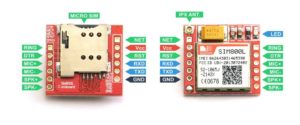GSM module that offers 2G GSM and GPRS data. It features small size and low power consumption. Twice size as a coin and the working current low to 1mA when in sleep mode. It uses a serial port communication, supports 3GPP TS 27.007, 27.005 and SIMCOM enhanced AT Commands. Also, it supports A-GPS technique that help get indoor position by the mobile network.
Works compatible with Arduino Uno, Arduino Mini, Raspberry Pi. A mini GSM antenna is came with, but an external power supply is required.
Features:
- Quad-band 850/900/1800/1900MHz
- GPRS multi-slot class12 connectivity: max. 85.6kbps (down-load/up-load)
- GPRS mobile station class B
- 3GPP TS 27.007, 27.005 and SIMCOM enhanced AT Commands
- Real Time Clock
- Power voltage 3.4V ~ 4.4V DC
- A-GPS (Assisted Global Positioning System)
- Supports 2.8V to 5.0V logic level
- Low power consumption, 1mA in sleep mode
- Compact size 23mm x 35mm x 5.6mm
- Standard SIM Card
Mini GSM / GPRS breakout board is based on SIM800L module, supports quad-band GSM/GPRS network, available for GPRS and SMS message data remote transmission.
The board features compact size and low current consumption. With power saving technique, the current consumption is as low as 1mA in sleep mode. It communicates with microcontroller via UART port, supports SIMCOM enhanced AT Commands.

Pinout description
There are 12 total pins on the small SIM800L two parallel rows of six headers. One row contains all of the pins required to interface with Arduino, the other row has all things for interface.
- GND: Ground for SIM800L
- VCC: Supply Voltage input for SIM800L
- RST: Reset pin for SIM800L
- RXD: Serial communication (Receiver Pin)
- TXD: Serial communication (Transfer Pin)
- NET: Antenna
- RING: Low state while receiving call
- DTR: Sleep mode
- MICP: Microphone +
- MICN: Microphone –
- SPKP: Speaker +
- SKPN: Speaker –
Hardware Required
- Small SIM800L
- Micro Sim
- Arduino Uno R3
- Solderless Breadboard
- Jumper Wires
- DC-DC Adjustable Step down Module
- 1kOhm resistor
- NPN transistor (we used BC 547)



